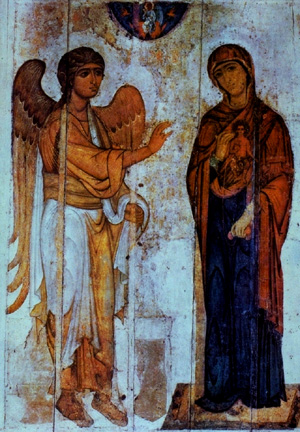
Santa Sophia in Kiev (modern Ukraine)
As the new country of Poland got stronger and stronger in the late 900s AD, it became more of a threat to Russia. The powerful Polish king Boleslaw conquered all the way east to Kiev (KEY-ev).
So gradually the new country of Russia got to be more and more friendly with the Byzantine Empire. Russia was trading with the Vikings, and the Vikings were also working as mercenary soldiers for the Byzantine Empire. And the Russians wanted the Byzantines to help them fight Poland. Naturally the Byzantine emperors (and the Poles too) wanted the Russians to become Christians. Around the year 1000, the Russians did become Christians. They started to build churches like the churches in Constantinople.

A Russian annunciation scene
Boleslaw died in 1027. So Jaroslaw, the Prince of Kiev, took advantage of the transition to Boleslaw’s son Mieszko II. He pushed Poland out of Ukraine in a big battle in 1031 AD. By 1067 AD, the Russians even moved their capital from Novgorod to Kiev.
Russia was the biggest country in Europe. Russian people got richer from trading Silk Road things between the Holy Roman Empire, the Byzantine Empire, the Islamic caliphate, and Central Asia. Russian traders also sold their own furs and amber on the Silk Road. And they bought steel swords, sugar, and knotted carpets.
But the Russians also made money as middlemen. They bought Silk Road steel from Iran on the shores of the Caspian Sea. They sold the steel to Vikings, and the Vikings carried the steel north-west to Europe to make swords.
Learn by doing: go to a Russian Orthodox church service
More medieval Russian history
Bibliography and further reading about medieval Russia: